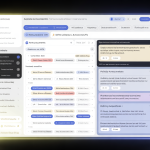
Case Studies and Real-World Examples: Integration of Data Analytics in Retail Operations
The integration of data analytics in retail operations has revolutionized the industry, enabling businesses to make more informed decisions, optimize processes, and enhance customer experiences.
This report explores real-world case studies and success stories in two critical areas of retail operations: data-driven inventory management and personalized marketing campaigns.
These examples highlight the power of data analytics in driving efficiency, improving customer satisfaction, and increasing profitability.
1. Success Stories of Data-Driven Inventory Management
1.1 Case Study: Walmart’s Inventory Management Optimization
Overview: Walmart, one of the world’s largest retailers, has long been a leader in leveraging data analytics for inventory management.
The company’s use of advanced data analytics has enabled it to optimize its supply chain, reduce costs, and ensure that products are available when and where customers need them.
Key Strategies:
-
Real-Time Inventory Tracking:
- Walmart implemented a real-time inventory tracking system across its global supply chain. This system uses RFID technology and IoT devices to monitor inventory levels in real-time, enabling the company to respond quickly to changes in demand.
- Result: This approach significantly reduced stockouts and overstock situations, leading to improved customer satisfaction and reduced holding costs.
-
Demand Forecasting with Machine Learning:
- Walmart uses machine learning algorithms to analyze historical sales data, weather patterns, and other external factors to forecast demand accurately. This enables the company to adjust inventory levels proactively.
- Result: The accuracy of demand forecasting improved, allowing Walmart to better align its inventory with customer demand, especially during peak seasons like Black Friday.
-
Vendor-Managed Inventory (VMI):
- Walmart adopted a vendor-managed inventory model, where suppliers are responsible for managing inventory levels based on real-time sales data shared by Walmart. This collaboration ensures that products are replenished efficiently.
- Result: VMI helped Walmart reduce lead times and maintain optimal inventory levels, further enhancing supply chain efficiency.
Outcomes:
- Cost Reduction: Significant reduction in inventory carrying costs and waste.
- Improved Customer Satisfaction: Higher product availability and fewer stockouts.
- Increased Efficiency: Streamlined supply chain operations and faster response to demand fluctuations.
1.2 Case Study: Zara’s Agile Inventory Management
Overview: Zara, the global fashion retailer, is renowned for its fast-fashion model, which relies heavily on agile and data-driven inventory management.
The company’s ability to respond quickly to fashion trends and customer demand is a key factor in its success.
Key Strategies:
-
Short Production Cycles:
- Zara’s inventory management system is designed for rapid production and distribution. The company collects real-time sales data from its stores and uses it to make quick decisions about restocking and new product launches.
- Result: Zara can bring new designs from concept to store shelves in just a few weeks, allowing it to capitalize on emerging trends before competitors.
-
Centralized Distribution System:
- Zara’s centralized distribution centers use data analytics to optimize the allocation of inventory to stores. The system monitors sales performance in each store and adjusts inventory levels accordingly.
- Result: This approach minimizes overstock and ensures that each store has the right mix of products to meet local demand.
-
Data-Driven Design and Production:
- Zara uses customer feedback and sales data to inform its design and production decisions. This ensures that the company produces what customers want, reducing the risk of unsold inventory.
- Result: Zara’s ability to align production with customer preferences has led to high sell-through rates and minimal markdowns.
Outcomes:
- Increased Revenue: Higher sales due to quick response to trends and customer demand.
- Reduced Waste: Minimal unsold inventory, leading to lower markdowns.
- Enhanced Customer Loyalty: Customers appreciate the constant flow of new, trendy products.
1.3 Case Study: Amazon’s Data-Driven Inventory and Fulfillment
Overview: Amazon’s success in e-commerce is largely attributed to its sophisticated use of data analytics in inventory management and fulfillment.
The company’s ability to predict demand, optimize inventory, and streamline fulfillment has set a new standard in the retail industry.
Key Strategies:
-
Predictive Analytics for Inventory Management:
- Amazon uses predictive analytics to forecast demand at a granular level. The company analyzes customer behavior, historical sales data, and external factors to anticipate which products will be in demand and where.
- Result: This allows Amazon to stock the right products in the right locations, reducing shipping times and costs.
-
Dynamic Inventory Allocation:
- Amazon’s inventory management system dynamically allocates inventory across its network of fulfillment centers based on real-time demand data. This ensures that products are closer to customers, enabling faster delivery.
- Result: The efficiency of Amazon’s fulfillment process has contributed to its reputation for fast, reliable delivery.
-
Automated Fulfillment Centers:
- Amazon’s use of robotics and automation in its fulfillment centers is driven by data analytics. The company optimizes the movement of goods within its warehouses to reduce picking and packing times.
- Result: Increased operational efficiency and the ability to handle large volumes of orders with speed and accuracy.
Outcomes:
- Faster Delivery: Reduced shipping times and improved customer satisfaction.
- Cost Efficiency: Lower operational costs due to optimized inventory and automation.
- Scalability: The ability to scale operations quickly to meet demand spikes, such as during holiday seasons.
2. Personalized Marketing Campaigns That Worked
2.1 Case Study: Starbucks’ Personalized Rewards Program
Overview: Starbucks is a prime example of how personalized marketing can drive customer engagement and loyalty. The company’s use of data analytics to tailor its rewards program and marketing messages has been highly successful in increasing customer retention and spending.
Key Strategies:
-
Customer Data Collection:
- Starbucks collects data on customer purchases, preferences, and behavior through its mobile app and loyalty program. This data is used to create detailed customer profiles.
- Result: Starbucks has a deep understanding of its customers’ preferences, enabling more targeted marketing efforts.
-
Personalized Offers and Rewards:
- Using predictive analytics, Starbucks sends personalized offers and rewards to customers based on their purchase history and preferences. These offers are delivered via the mobile app, email, or push notifications.
- Result: The personalized offers have led to higher redemption rates and increased customer spending.
-
Gamification and Engagement:
- Starbucks uses gamification in its rewards program, encouraging customers to make repeat purchases to earn rewards and reach higher tiers. The company tailors the gamification elements to individual customer behaviors and preferences.
- Result: The gamified experience has enhanced customer engagement and loyalty, driving repeat visits and purchases.
Outcomes:
- Increased Customer Loyalty: Higher retention rates due to personalized rewards and offers.
- Higher Revenue: Increased average spend per customer as a result of targeted promotions.
- Enhanced Customer Experience: Positive feedback from customers who feel valued through personalized interactions.
2.2 Case Study: Sephora’s Omnichannel Personalization
Overview: Sephora, a global beauty retailer, has successfully integrated data analytics into its omnichannel marketing strategy, creating personalized experiences for customers both online and in-store.
The company’s use of data-driven personalization has set it apart in the highly competitive beauty industry.
Key Strategies:
-
360-Degree Customer View:
- Sephora combines data from its online store, mobile app, and in-store interactions to create a 360-degree view of each customer. This data includes purchase history, product preferences, and browsing behavior.
- Result: The comprehensive customer profiles enable Sephora to deliver highly personalized experiences across all channels.
-
Personalized Product Recommendations:
- Sephora uses AI-driven algorithms to provide personalized product recommendations both online and in-store. These recommendations are based on the customer’s past purchases, preferences, and current trends.
- Result: Personalized recommendations have increased conversion rates and customer satisfaction.
-
Tailored Content and Offers:
- Sephora personalizes its marketing content, including emails, app notifications, and in-store promotions, based on customer segments and individual preferences. The company also offers personalized beauty advice and tutorials.
- Result: Tailored content has led to higher engagement and stronger customer relationships.
Outcomes:
- Improved Conversion Rates: Higher sales due to personalized product recommendations.
- Stronger Customer Relationships: Enhanced loyalty through personalized content and interactions.
- Increased Engagement: Higher engagement across channels, leading to more frequent purchases.
2.3 Case Study: Netflix’s Content Personalization
Overview: Netflix is a pioneer in using data analytics for personalized marketing and content recommendations.
The company’s ability to deliver personalized experiences has been a key factor in its global success.
Key Strategies:
-
Behavioral Data Analysis:
- Netflix collects vast amounts of data on user behavior, including viewing history, search queries, and interaction with the platform. This data is used to build detailed profiles of each user.
- Result: The deep understanding of user preferences allows Netflix to tailor its content recommendations to individual tastes.
-
Personalized Content Recommendations:
- Netflix’s recommendation engine uses machine learning algorithms to suggest content that is most likely to appeal to each user. The recommendations are based on a combination of user behavior, content attributes, and collaborative filtering.
- Result: Personalized recommendations account for a significant portion of the content viewed on Netflix, driving engagement and satisfaction.
-
Dynamic Personalization:
- Netflix dynamically personalizes the user interface, including the order of content categories, thumbnails, and promotional banners, based on individual viewing habits and preferences. This level of personalization ensures that each user’s experience on the platform is unique and tailored to their specific interests.
- Result: This dynamic personalization not only increases the likelihood of content discovery but also keeps users engaged with the platform for longer periods.
Outcomes:
- Increased User Engagement: Personalized content recommendations have led to higher viewing times and greater user satisfaction.
- Reduced Churn: By consistently delivering content that users love, Netflix has successfully reduced customer churn rates.
- Data-Driven Content Creation: The insights gained from user behavior have also informed Netflix’s content creation strategy, leading to the development of original shows and movies that resonate with its audience.
3. Integration of Data Analytics in Retail Operations: Key Lessons and Best Practices
3.1 The Importance of Data Integration
One of the key lessons from these case studies is the importance of integrating data across all retail operations, including inventory management, marketing, and customer experience.
By breaking down data silos and creating a unified view of the customer and the supply chain, retailers can make more informed decisions and deliver a more consistent and personalized experience.
Best Practices:
- Implement Integrated Data Platforms: Use platforms that integrate data from various sources, such as CRM, ERP, and marketing automation systems, to create a comprehensive view of the business.
- Real-Time Data Processing: Invest in technologies that allow for real-time data processing and analysis, enabling more agile decision-making.
3.2 Leveraging Advanced Analytics and AI
Another critical factor in the success of these retailers is their use of advanced analytics and AI.
Whether it’s for demand forecasting, personalized marketing, or customer engagement, AI and machine learning provide the tools needed to analyze vast amounts of data and make accurate predictions.
Best Practices:
- Adopt AI-Powered Tools: Use AI and machine learning algorithms to enhance data analysis, improve forecasting accuracy, and personalize customer interactions.
- Continuously Train Models: Ensure that AI models are continuously trained and updated with new data to maintain their effectiveness over time.
3.3 Focusing on Customer-Centric Strategies
A common theme across these case studies is the focus on the customer.
Whether it’s tailoring inventory to meet demand or personalizing marketing messages, putting the customer at the center of all decisions leads to better outcomes.
Best Practices:
- Build Customer Profiles: Collect and analyze customer data to create detailed profiles that inform personalized marketing and inventory strategies.
- Personalize Every Touchpoint: Ensure that every interaction, from the first ad to the final purchase, is personalized based on the customer’s preferences and behavior.
3.4 Agility and Responsiveness
The ability to respond quickly to changes in customer demand or market conditions is crucial.
Retailers like Zara and Amazon have demonstrated the value of agility in both inventory management and marketing.
Best Practices:
- Implement Agile Inventory Management: Use data-driven insights to adjust inventory levels and product assortments quickly in response to changing demand.
- Flexible Marketing Strategies: Develop marketing campaigns that can be easily adjusted based on real-time data and customer feedback.
4. Future Trends in Data-Driven Retail Operations
4.1 Predictive Analytics and Forecasting
The future of data-driven retail operations will likely see even greater reliance on predictive analytics and forecasting.
As data collection becomes more sophisticated, retailers will be able to predict trends and customer behavior with even greater accuracy.
Trend Impact:
- Proactive Inventory Management: Retailers will be able to anticipate demand more accurately and stock products accordingly, reducing the risk of stockouts and overstocks.
- Enhanced Personalization: Marketing campaigns will become even more personalized, with offers and recommendations tailored to individual customers in real time.
4.2 Omnichannel Integration
As customers continue to expect seamless experiences across multiple channels, the integration of data and operations across online and offline touchpoints will be critical.
Retailers will need to ensure that inventory, marketing, and customer service are aligned across all channels.
Trend Impact:
- Unified Customer Experience: A consistent experience across all channels will enhance customer satisfaction and loyalty.
- Efficient Operations: Better integration will lead to more efficient operations, with inventory and marketing strategies that are coordinated across all sales channels.
4.3 Ethical Data Use and Privacy
With increasing concerns about data privacy, retailers will need to balance personalization with ethical data practices.
Transparency and consent will become more important, and retailers will need to ensure that they are using data in ways that respect customer privacy.
Trend Impact:
- Trust and Loyalty: Retailers that are transparent about how they use customer data and who prioritize privacy will build stronger trust and loyalty with their customers.
- Regulatory Compliance: Compliance with data protection regulations will be essential to avoid penalties and maintain customer confidence.
The integration of data analytics into retail operations has transformed the industry, enabling retailers to optimize inventory management, personalize marketing campaigns, and deliver exceptional customer experiences.
The success stories of companies like Walmart, Zara, Amazon, Starbucks, Sephora, and Netflix demonstrate the power of data-driven strategies in achieving operational efficiency and customer satisfaction.
By focusing on customer-centric strategies, leveraging advanced analytics and AI, and maintaining agility in their operations, these retailers have set a high standard for the industry.
As technology continues to evolve, the future of retail will be shaped by even more sophisticated data analytics tools, greater integration across channels, and a renewed focus on ethical data use.
Retailers that embrace these trends and best practices will be well-positioned to thrive in the competitive landscape, delivering personalized and efficient experiences that meet the needs of today’s consumers.
This comprehensive report highlights the importance of integrating data analytics into retail operations, providing real-world examples and best practices that can guide businesses in optimizing their inventory management and marketing strategies.
By learning from the success of leading retailers, businesses can implement data-driven approaches that enhance their operations and drive growth.
Back to How to Use Data Analytics Main Page



